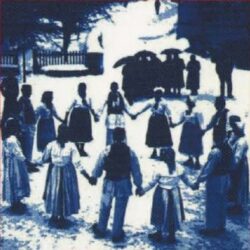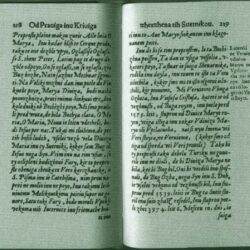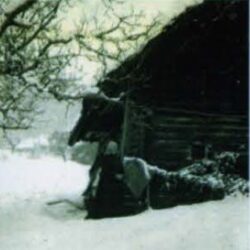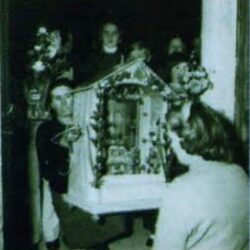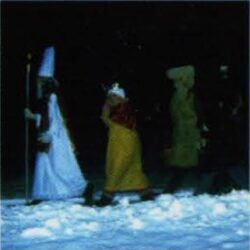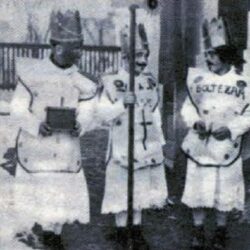Winter Kolednica: Seasonal Carols from Slovenia

GNI 42.406
Recorded: Vrtobja, Primorska, 1984
Performed by: Roman Arčon, Jožef Nemec and Peter Štakul
GNI M 31.705
Recorded: Andovci, Porabje, 1970
Performed by: Emil Mesič
GNI M 46.462
Recorded: Ilirska Bistrica, Primorska, 1995
Performed by: Nina and Romeo Volk
GNI DAT Ci T 13
Recorded: Tomaž, Štajerska, 1999
Performed by: A group of singers
GNI T 663
Recorded: Gorca in Halozah, Štajerska, 1969
Unknown performer
GNI M 46.623
Recorded: Mačkolje near Trstu, Primorska, 1994
Performed by: Ljuba Smotljak
GNI M 46.446
Recorded: Videm-Dobrepolje, Dolenjska, 1995
Performed by: Jože Zajc
GNI M 25.437
Recorded: Liščaca, Resia, 1962
Performed by: Luigia di Floriano, Siega Pasqua and Anna di Floriano
GNI M 25.572
Recorded: Dobrepolje, Dolenjska, 1963
Performed by: Ančka Lazar
GNI M 30.657
Recorded: Hotedršica, Notranjska, 1997
Performed by: Leopold Pivk
GNI M 29.817
Recorded: Prerad, Štajerska, 1969
Performed by: Jakob Majcen, Franček Štebih and Janez Simonič
GNI M 46.469
Recorded: Sodevci, Bela Krajina, 1995
Performed by: Tamburitza group from Sodevci
CD 1995
Recorded: Bela Krajina, 1995
Performed by: Folklore group Ivan Navratil from Metlike
GNI M 46.904
Recorded: Železniki, Gorenjska, 1994
Performed by: Zdravko Debeljak
a) Frišči, frišči, zdravi bodte
GNI M 31.705
Recorded: Andovci, Porabje, 1970
Performed by: Atila Mesič
b) Rešte se rešte se
GNI M 39.686
Recorded: Podroje Globasnici, Koroška, 1980
Performed by: Bernardeta Sadovnik
c) Šip šap
GNI M 37.890
Recorded: Velinja Vas, Koroška, 1977
Performed by: Ana Krušič
d) Šap šap
GNI M 37.996
Recorded: Kazaze, Koroška, 1977
Performed by: Marija Gaser
e) Šipe šape – Bog daj srenčo
GNI M 35.856
Recorded: Zahomec, Koroška, 1976
Performed by: Mik Kriegl
GNI DAT 4
Recorded: Stara Vrhnika, Notranjska, 1994
Performed by: Primož Ogrin, Primož Suša, Marko Bogataj, Marko Nagode and Jernej Petrovčič
GNI M 48.311
Recorded: Kovača Vas, Štajerska, 1999
Performed by: Vaberški Fantje from Kovača Vas
GNI M 48.545
Recorded: Špeter, Slovenian Veneto, 1999
Performed by: Elizijo Jussa
GNI M 31.867
Recorded: Krčanje, Koroška, 1969
Performed by: Singer from Krčanje
GNI M 30.042
Recorded: Velika Varnica, Štajerska, 1969
Performed by: A group of singers
GNI M 46.892
Recorded: Beltinci, Prekmurje, 1994
Performed by: Marko Banda from Beltinci
GNI M 43.751
Recorded: Kostanjevica, Dolenjska, 1986
Performed by: A group of singers
GNI M 47.432
Recorded: Lovrenc na Dravskem Polju, Štajerska, 1998
Performed by: “Fantje iz treh vasi” from Lovrenc na Dravskem Polju
GNI M 48.006
Recorded: Dobrava, Štajerska, 1999
Performed by: A group of koledniki
GNI M 45.771
Recorded: Podlehnik, Štajerska, 1990
Performed by: Franc Laporšek
GNI M 30.046
Recorded: Velika Varnica, Štajerska, 1969
Performed by: Singers from Velika Varnica
GNI M 48.317
Recorded: Ložnica pri Makolah, Štajerska, 1999
Performed by: Singers from Ložnica near Makole
CD 1995
Recorded: Bela Krajina
Performed by: Ivan Navratil Folklore Group from Metlika
GNI M 29.164
Recorded: Gorje, Gorenjska, 1968
Performed by: Janez and Lorenc Jan
Winter Kolednice in Slovenia
At the heart of Europe, where the Balkan Peninsula meets the Apennine Peninsula and the Danube Basin meets the Adriatic Sea, lies Slovenia. The country, nestled between Austria, Hungary, Croatia and Italy, has a population of just under two million. Its capital city is Ljubljana. Its language, Slovene, is a member of the South Slavic family. Beyond the official borders of Slovenia, Slovenes can be found in areas of Austria, Hungary, Croatia and Italy. There are around 500,000 Slovene emigrants living in other countries around the world. All of these Slovenes – those in Slovenia, those living in Slovene areas outside the borders and those scattered around the world – are linked by a common culture and tradition and constitute a uniform Slovene cultural area. In the past, this common culture and tradition shaped the national identity and national consciousness of the Slovenes and, despite the influences of the Romance, Germanic, Magyar and Yugoslav worlds, the Slovene area formed and preserved its own unique cultural images, which largely belongs to the Alpine area.
Thanks to their way of life and respect for tradition, Slovenes have managed to conserve, to the present day, many relics of the past in both their material and spiritual cultures. The most characteristic form of musical expression of the Slovenes is singing, although the instrumental tradition is also important. Slovene folk songs consist of narrative songs (legendary songs, historical songs, social songs, etc.) and lyrical songs (children’s songs, love songs, ceremonial songs, etc.). Slovene folk songs are in major keys and are usually for three or more voices. The leading voice usually takes the middle part, the upper voice follows it a third above, and the bass line moves around the basic harmonic intervals. When these three voices are joined by a fourth voice, the fourth part interweaves among the other three, sometimes even ascending beyond the upper part. Songs are usually sung loudly, without changes of dynamics or tempo, and in a slow, drawn-out manner.
Singing was often connected to customs, and one such custom is koledovanje, where a group of people (koledniki) go from house to house in and around the village on certain feast days and sing songs appropriate to the occasion (although sometimes the greetings are spoken). The greetings bring happiness and blessings to the house and its inhabitants, to the animals and to the fiels, and thus the koledniki are repaid with gifts. The koledniki perform a kind of religious function and folk beliefs ascribe them supernatural power. Best known is koledovanje at Christmas, New Year and the Epiphany, although there are also other types which differ considerably in terms of time and place. Most of the koledniki are men, although children and women occasionally take part. As a rule the singing is done without instrumental accompaniment.
In all probability these ritual visits from house to house derive from pagan times. The name koleda derives from the word calendae, the ancient name for ritual house-to-house visits to mark the New Year which our ancestors probably adopted from the Romans. It is likely that during the period of Christianisation – or through the intervention of Christians – the word koleda began to be used for house-to-house visits at Christmastide. The first written reference to koledovanje in Slovenia dates from the second half of the 16th century when Primož Trubar, the author of the first book in Slovene, refers to it as an ancient tradition.
The melodies of the songs of the koledniki do not differ greatly from other folk songs. The words usually contain a greeting to the house, a description of the event, a request for gifts, an expression of good wishes, thanks for the gifts and a solemn farewell. In the past koledniki were given food; these days it is customary to give them money. At one time this custom would have helped some of the poorer singers get through the winter. Today the gifts are usually collected for charitable purposes.
The album contains examples of various sung or recited kolednice (carols) and some songs from the Christmas and New Year period. These are just a small part of Slovenia’s rich musical tradition. Some dance tunes have also been added for their seasonal importance.
The beginning of the Winter koledovanje is announced by a St. Barbara’s Day carol (track 2). In eastern Slovenia on the evening before St. Barbara’s Day (4 December) singers known as polajžarji go from house to house wishing happiness. Koledovanje also used to be a feature of the pig slaughter in winter. At slaughter time children (mainly the poorer ones) would go from house to house, sing a song of good wishes and recieve in exchange some pork or sausage. These day there is no longer koledovanje at slaughter time but in some areas songs are still sung at this domestic celebration (track 4).
Christmas carol-singing (24 and 25 December) preserved pagan beliefs which are, however combined with the Christian message. This period is closely connected to nature and the winter solstice, when the days start to get longer. At Christmas time koledniki would go fro mhouse to house and sing songs. Today, however, Christmas is more of a family holiday. People celebrate at home and sing various Christmas songs (tracks 6, 8 and 9). In eastern Slovenia it was the custom on the day after Christmas, 26 December, or St. Stephen’s Day, when the horses are blessed, to sing or recite St. Stephen’s Day carols. This usually happened on the eve of the holiday or first thing in the morning (track 11). Carols are not sung on 27 December, the feast of St. John the Evangelist, but at Predgrad in the Poljane Valley it used to be the custom to dance a round dance or kolo to mark the winter solstice; Christianity ‘disguised’ this custom with celebrations and dances to mark St. John’s Day. They danced to the old ballad Pobelelo polje z ovcama which tells the story of three women to tear out a young man’s heart (track 13).
Koledovanje to mark the New Year also includes tepežkanje-Holy Innocents, today known best as a holiday for children who use this day to ‘thrash’ grown-ups without being punished. On this day, 28 December, we also remember the Holy Innocents massacred by Herod. Once upon a time it was adult men who went ‘thrasing’ and with their ‘miraculous’ rods restored vital energy (track 15). The transition from the old year to the new year is a time when people exchange greetings and wish each other all the best for the new year. That is why even today New Year’s koledniki travel around the countryside wishing people health and happiness and blessing their houses (tracks 17, 19 and 20).
As the Gospel tells us, Caspar, Melchior and Balthazar, variously known as the Three Kings, the Three Wise Men or the Magi, followed a star until they found the Baby Jesus. Then they bowed down before him and offered him gifts. In Europe, the singing of Epiphany carols on 5 January, the eve of the feast of the Epiphany, has its roots in medieval dramatic rituals and is today the most widespread form of koledovanje in Slovene ethnic territory (track 22, 23, 24). At Candlemas, 2 February, candles are blessed to remember the Purification of the Virgin Mary and the presentation of Christ in the Temple. In the popular religious tradition Candlemas means the end of the Christmas period. In eastern Slovenia it is also marked by Candlemas carol-singing, a tradition which has also been adopted by female singers (tracks 26, 27).
The compact disc contains a series of documentary recordings of Slovenian kolednice. The songs are recorded on various types of equipment and therefore the quality of some of the recordings, particularly the older ones, is slightly poorer. All the recordings with the exception of tracks 13 and 29 are kept by the archives of the Institute of Ethnomusicology of the Scientific Research Centre of the Slovenian Academy of Sciences and Arts in Ljubljana. In these recordings you can hear thirty-four different singers and groups from various parts of the Slovenian ethnic territory. Some of the songs are not kolednice but they have been included in this presentation because they are songs that are traditionally sung during the Christmas/New Year period.
Between the songs I have also included instrumental recordings and examples of festive bell-ringing and chiming. These add variety to the compact disc and serve as an introduction to traditional Slovene instrumental music as it was once hear – and is still heard today in places – on feast day and holidays and as part of daily life.
Maša Komavec
Institute of Ethnomusicology, Scientific Research Centre of the Slovenian Academy of Sciences and Arts
